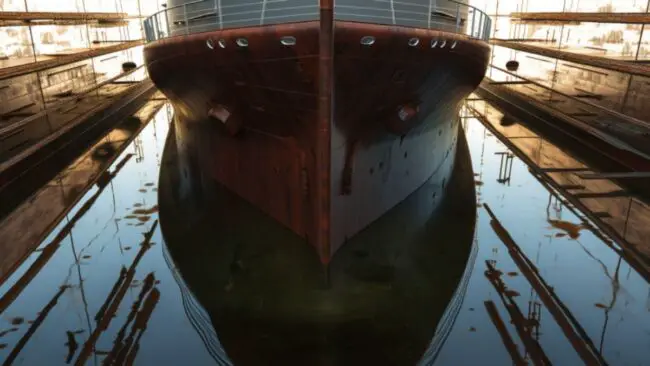Did you know that the bottom of a ship has a specific name? It’s called the hull, and understanding its various parts can provide fascinating insights into the inner workings of a vessel. In this article, we will delve into the world of ship hulls, exploring their different components and how they look, allowing you to gain a deeper understanding of these extraordinary structures.
So, if you’ve ever wondered about the bottom of a ship and how it’s put together, look no further! Let’s dive straight into the world of ship hulls and explore each part in detail.
Table of Contents
The Bottom of a Ship: What is it Called and How Does it Look? Each Part Explained
The bottom of a ship, also known as the hull, is a crucial component that determines the vessel’s stability, speed, and overall performance in the water. It is the part of the ship that is in direct contact with the water and plays a vital role in ensuring the ship’s buoyancy and maneuverability.
In this article, we will explore the various parts of a ship’s hull and how each part contributes to its overall design and functionality.
1. Keel
The keel is the central structural backbone of a ship’s hull. It runs along the bottom centerline of the vessel from bow to stern. The keel provides stability and prevents the ship from rolling excessively. It also supports the weight of the ship and helps maintain its structural integrity. In some ships, the keel may extend further below the waterline to enhance stability.
2. Bilge
The bilge is the lowest part of the ship’s hull, where the bottom meets the sides. It is typically curved in shape to facilitate the flow of water and prevent stagnation. The bilge area is essential for collecting and removing any excess water that may accumulate in the ship, ensuring that it remains balanced and free from damage caused by excessive water accumulation.
3. Strakes
Strakes are longitudinal plates or planks that run horizontally along the ship’s hull. They are designed to provide additional strength and rigidity to the hull structure while also assisting in the efficient flow of water. Strakes help reduce drag and improve the ship’s hydrodynamics, enhancing its speed and maneuverability.
4. Chines
Chines are the edges or corners formed where the ship’s bottom and sides meet. They are often angled or curved to optimize the flow of water. Chines play a crucial role in controlling the ship’s stability and maneuverability by influencing the way water interacts with the hull. They can impact how the ship turns, rolls, and tracks through the water.
5. Transom
The transom is the flat or curved surface that forms the rear of the ship’s hull. It provides structural support and helps maintain the ship’s shape. The transom is where the ship’s propulsion system, such as the propeller, is usually mounted. It also acts as a barrier to prevent water from entering the ship’s interior.
6. Rudder
The rudder is a movable fin-like structure attached to the ship’s hull near the stern. It is essential for steering and maneuvering the ship. By changing the angle of the rudder, the helmsman can control the direction of the ship, allowing it to turn, change course, or maintain a straight path. The rudder works in conjunction with other controls, such as the ship’s engine and propellers, to ensure smooth navigation.
7. Sonar Dome
The sonar dome is a specialized structure located on the ship’s hull, often near the bow. It houses the ship’s sonar system, which is used for underwater navigation, detecting objects, and mapping the seafloor. The sonar dome is designed to minimize interference from the ship’s hull and ensure accurate sonar readings.
8. Anti-fouling Paint
The bottom of a ship is also treated with anti-fouling paint. This special type of coating helps prevent the growth of marine organisms, such as barnacles and algae, on the hull. These organisms can increase drag and decrease the ship’s speed and fuel efficiency. Anti-fouling paint reduces the maintenance required to keep the ship’s bottom clean and smooth, ensuring optimal performance.
9. Ballast
Ballast refers to the heavy material, such as water, sand, or rocks, placed in the bottom of a ship’s hull. It helps stabilize the ship by lowering its center of gravity and increasing its overall weight. Ballast tanks can be filled or emptied as needed to adjust the ship’s stability and balance, depending on cargo load, weather conditions, or other factors.
10. Bilge Keel
Bilge keels are additional keel-like structures found on each side of a ship’s hull. They provide lateral stability and help reduce rolling motion caused by waves or rough seas. Bilge keels act as hydrodynamic fins, redirecting water flow and reducing the ship’s tendency to roll excessively. They play a critical role in enhancing passenger comfort and preventing cargo damage.
The bottom of a ship, known as the hull, is a complex and carefully designed structure that influences the vessel’s stability, speed, and performance. Each part of the ship’s hull, from the keel to the bilge, strakes, chines, transom, rudder, sonar dome, anti-fouling paint, ballast, and bilge keel, serves a specific purpose in ensuring the ship’s seaworthiness and maneuverability.
Understanding these components helps us appreciate the engineering behind maritime vessels and the importance of maintaining their integrity for safe and efficient navigation on the open seas.
Ship Parts and Terminology Explained! (saVRee Nuggets)
Frequently Asked Questions (FAQs)
The bottom part of a ship is called the hull. It is the main body of the ship that extends below the waterline. The hull is typically streamlined and curved to reduce drag and improve the ship’s performance.
Bilge keels are vertical plates attached to the sides of a ship’s hull. They are located on both sides near the bottom of the ship and extend horizontally below the waterline. Bilge keels help to reduce rolling motion and improve stability.
A bulbous bow is a protruding bulb-like structure located at the front of a ship’s hull below the waterline. It is designed to reduce drag and increase fuel efficiency by improving the ship’s hydrodynamic performance.
Propellers are rotating blades that provide propulsion to a ship. They are typically located at the rear or stern of the ship. The number and arrangement of propellers vary depending on the size and type of the vessel.
Sea chests are compartments built into the bottom of a ship’s hull. They serve as an inlet for raw seawater that is used for various ship systems, such as cooling engines and supplying firefighting equipment.
Sacrificial anodes, also known as zinc anodes, are metal objects attached to the hull of a ship. They are made of a metal that is more reactive than the ship’s hull material, such as zinc or aluminum. Sacrificial anodes prevent corrosion by corroding themselves instead of the ship’s hull.
Skegs are fin-like structures located on the lower part of a ship’s hull, usually at the stern or rear. They provide stability and support to the ship’s rudder, helping to prevent damage and improve steering control.
A keel is the central longitudinal structural element of a ship’s hull. It runs along the bottom centerline from bow to stern. The keel provides stability, strength, and support to the ship, helping it to withstand the forces of waves and maintain balance.
Final Thoughts
The bottom of a ship, also known as the hull, is a crucial component that enables the vessel to move smoothly through water. It is divided into several distinct parts, each serving a specific purpose. The keel, running along the centerline, provides stability and prevents the ship from capsizing. The bilge keels assist in reducing roll motion, while the bow and stern sections help with steering and handling. The rudder, positioned at the stern, controls the ship’s direction.
Finally, the propeller, located at the aft end, propels the ship forward. Understanding these different parts allows for a comprehensive grasp of the bottom of a ship and its overall functionality.






